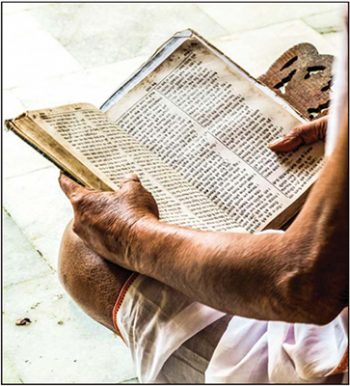A condensed translation from the Agamas revealing the holy names of Siva and extolling the eternal, pure qualities of God’s Supreme Reality
The following is a lucid translation of Vyoma Vyapine, a long mantra often chanted by priests during temple puja. This mantra is found in chapter ten of the Raurava Agama.
OM. Uniquely denoting a pure plane which is transcendent and indestructible.
Vyoma vyāpine. Vyoma is the supreme space. Because of its pervasive nature and immeasurable vastness, it is called vyoma.
Vyomarūpāya. Being associated with forms without losing all-pervasive nature for the benefit of the worlds, He is called Vyomarupa.
Sarvavyāpine. The Supreme Lord, identical with all-pervasive space, is called Sarvavyapi.
Śivāya. Salutations to Siva, who is the guru, who is eternally free from desire (raga) and the aspects related to embodiment.
Anantāya. Because of His immeasurable greatness and His quality of being eternally unborn, this Lord is well praised as Ananta.
Anāthāya. Being eternally associated with everlasting existence and being the Absolute Lord of all Deities, devas, asuras and other beings, Paramesvara is eulogized as Anatha.
Anāśritāya. As there is no equal to His being the final and ultimate resort, He is considered to be Anasrita.
Dhruvāya. Dhruva is unchangeable constancy. One of the important characteristics of being Sadasiva is to remain constant, forever absorbing every thing into Himself at the time of final and total dissolution known as Mahapralaya.
Śaśvatāya. The absolute authority in issuing instructions and guidance lies with Him because of His unexcelled eminence and spontaneous compassion.
Yogapīṭha saṁsthitāya. Lord Siva constantly remains established in the yoga of sivasadbhava—the unique system of yoga exclusively belonging to Siva, centered on being eternally free from anava, karma and maya.
Nityayogine. Being ever-relevant and superior to all other systems of yoga, He is called Nityayogi by the experts in the essential nature of tattvas, or categories of existence.
Dhyānāhārāya. Seated on the yoga pedestal with uninterrupted contemplation, Siva is adored as Dhyanahara.
Aum namaḥ śivāya, sarvaprabhave. On this ground, Lord Siva, who is always in a state of calmness, is identified with Aum and na-mah (where na denotes the dispelling activity and ma denotes uncertainty, doubt or disorder).
Śivāya. He is always blissful, compassionate and auspicious, irrespective of form or formlessness. He is known as Siva.
Īsānamūrdhāya. Siva is designed with five great Brahma mantras [Isana, Tatpurusha, Aghora, Vamadeva and Sadyojata]. Therefore, He is fittingly praised as Isana Murdha.
Tatpurusha vaktrāya. Being free of maya’s affects, He reveals the supreme knowledge in the form of Vedas and Agamas. With this mantra He fills up the entire range of the worlds.
Aghora hṛdayāya. Aghora means the one who is disposed to fight against evils and disorders. Aghoram means the state of undisturbed tranquility, and by this strand it denotes the complete awareness of all existing things.
Vāmadeva guhyāya. The meaning of this mantra is to secretly manage transmigration and remain concealed in all the worlds, objects and beings.
Sadyojāta mūrtaye. Sadya means one who grants the state of well-being instantly. He himself remains uncreated, Ajata.
Om namo namaḥ. Imperishable form.
Guhyāti guhyāya. He is called Guhyati-guhyaya by virtue of His power of concealment and secrecy.
Goptre. By guarding siddhis, spiritual powers, He is called Goptre.
.000
Nidhanāya. The One who performs the roll of destruction.


Pervading supreme space: The introduction to this chapter states, “Such impeccable meaning streamed forth from the self-luminous and ever-pure face of the Lord of all Deities, like flashes of lightning.”
DR. S. P. SABHARATNAM SIVACHARYAR, of the Adisaiva priest lineage, is an expert in ancient Tamil and Sanskrit, specializing in the Vedas, Agamas and Silpa Shastras. This excerpt is from his translation of the Raurava Agama.

